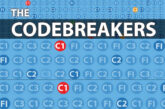
Need help with cracking those EICR codes? The technical team at NAPIT, with the help of the 18th Edition Codebreakers publication, answer your latest coding queries. Click on the photos for a closer look!
ERIC WILLIAMS: I WAS ASKED BY A CUSTOMER TO REPLACE A BROKEN SOCKET THAT WASN’T WORKING AND TRACED THE WIRING BACK TO A CIRCUIT BREAKER IN AN OFF-PEAK CONSUMER UNIT. ON CHECKING THE SOCKET AFTER REPLACEMENT, WITH THE OFF PEAK NOW ENERGISED, IT WAS FOUND TO HAVE REVERSED POLARITY. ON OPENING THE OFF-PEAK CONSUMER UNIT (PICTURED) THAT WAS INSTALLED APPROX. 40 YEARS AGO (SUPPLYING FIVE STORAGE HEATERS), I FOUND THE METER TAILS REVERSED, ALSO EACH OF THE TAILS PASSING THROUGH A DIFFERENT OPENING IN THE METAL ENCLOSURE, NEITHER OF WHICH HAD GROMMETS!
You can never assume that an older installation was installed, commissioned, and tested correctly. We often find that older installations can harbour some poor and dangerous practices. As we work through the findings, the lack of grommets is no more than perhaps a C3 unless there is mechanical and thermal damage. They’ve not been there for 40 years, without either, but that’s not to say every installation would be like this. Eddy currents only really start to take effect on equipment subjected to continual high current loads. In domestic single and polyphase installations, up to 100 A, it’s very unlikely there will be a problem.
We generally see Eddy current overheating and damage on polyphase commercial and industrial installations, dealing with larger loads. In this case, the installation is only 60 A, and storage heaters are only energised for a cyclic period so, unless there are signs of thermal damage, no more than a C3.
There also appear to be some cable entry points not being used, which are likely to represent an IP issue. One certainly seems to have almost direct access to the bus bar. The area of concern here is the reversed polarity, which may well operate normally in a healthy circuit. Older storage heaters generally don’t have complex electronic controllers that require correct polarity and subsequently don’t have reversed polarity diode protection, which stops the equipment from operating and forces maintenance to be carried out.
Also, as the polarity is reversed, we now have switches in neutral conductors, which isn’t allowed, and no individual circuit isolation, as the MCBs are only isolating the neutral. Not noticing the reversal, a maintenance engineer would think they have isolated a circuit to carry out some maintenance, only to find that the neutral circuit conductors are still live.
The only way to isolate any of the installation storage heaters would be to isolate them at the CU main isolator.
To order your copy of NAPIT Codebreakers click here









